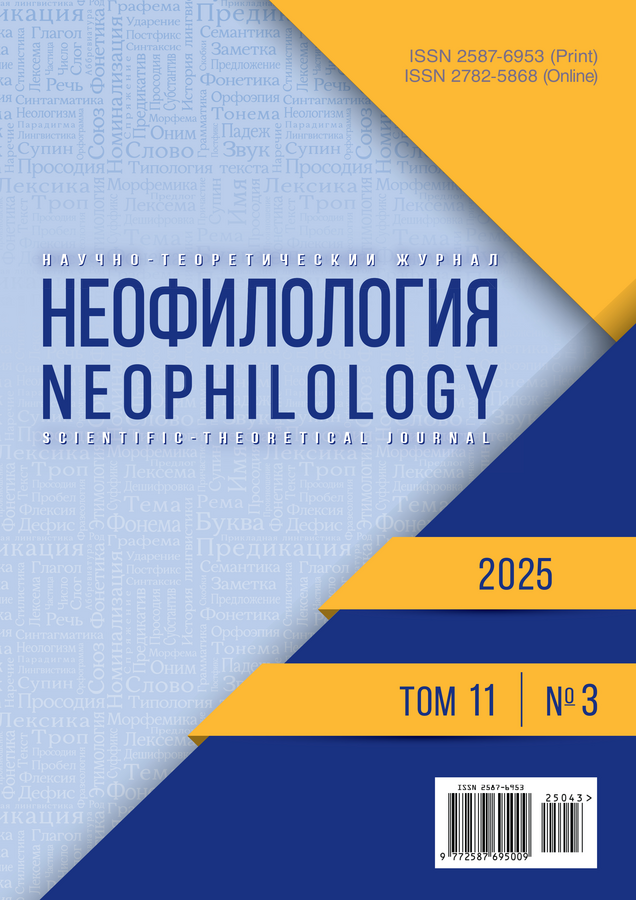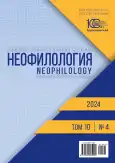Средства привлечения и удержания внимания в персонифицированных видеоблогах демонстрационного типа
- Авторы: Шестерина А.М.1
-
Учреждения:
- ФГБОУ ВО «Московский государственный университет им. М.В. Ломоносова»
- Выпуск: Том 10, № 4 (2024)
- Страницы: 977-986
- Раздел: МЕДИАКОММУНИКАЦИИ И ЖУРНАЛИСТИКА
- URL: https://journal-vniispk.ru/2587-6953/article/view/295636
- DOI: https://doi.org/10.20310/2587-6953-2024-10-4-977-986
- ID: 295636
Цитировать
Полный текст
Аннотация
ВВЕДЕНИЕ. Активное развитие аудиовизуального сектора новых медиа в высококонкурентной среде предполагает, что авторы контента активно работают над развитием средств привлечения и удержания внимания аудитории на конкретном произведении. Особенно ярко этот процесс реализуется в персонифицированных видеоблогах демонстрационного типа, где автор, как правило, остаётся один на один с аудиторией. А потому представляется целесообразным проанализировать те средства, которые используют видеоблогеры в своих произведениях с целью обеспечения их популярности.МАТЕРИАЛЫ И МЕТОДЫ. Эмпирическую базу исследования сформировали публикации на каналах “The Kate Clapp” и “Sasha Spilberg” на платформе YouTube с 1 сентября 2023 г. по 1 сентября 2024 г. Исследование осуществлялось с опорой на текстологический, сравнительно-типологический методы и метод контент-анализа.РЕЗУЛЬТАТЫ ИССЛЕДОВАНИЯ. В ходе исследования мы пришли к выводу о том, что блогеры чрезвычайно активно работают как с визуальными, так и с аудиальными субмодальностями. К часто используемым визуальным субмодальностям относятся местоположение, размер, игра с цветом, использование графических элементов. К аудиальным субмодальностям – громкость и чередование речи, музыки и шума. Также удалось установить взаимосвязь между частотностью использования визуальных и аудиальных субмодальностей: как правило, блогер, активно работающий с одними, чаще обращается и к другим. Наиболее популярны субмодальности, общие для сетевого видеоконтента и традиционного телевидения. Однако в сфере видеоблогинга их концентрация в произведении в среднем выше, чем на телеэкране.ЗАКЛЮЧЕНИЕ. Субмодальности позволяют блогеру привлечь и удержать внимание аудитории на произведении. В ходе исследования удалось установить корреляцию между частотностью использования субмодальностей и степенью интереса аудитории к фрагменту видеоролика: в эпизодах, где концентрация субмодальностей выше, отмечается всплеск интереса пользователей к медиаконтенту.
Об авторах
А. М. Шестерина
ФГБОУ ВО «Московский государственный университет им. М.В. Ломоносова»
Автор, ответственный за переписку.
Email: shesterina8@gmail.com
ORCID iD: 0000-0001-7270-2376
доктор филологических наук, профессор, заместитель декана по научной работе Высшей школы (факультета) телевидения
119991, Российская Федерация, г. Москва, Ленинские Горы, 1Список литературы
- Вартанова Е.Л. К вопросу о последствиях цифровой трансформации медиасреды // Меди@льманах. 2022. № 2. С. 8-14. https://doi.org/10.30547/mediaalmanah.2.2022.814, https://elibrary.ru/yrzxdz
- Вартанова Е.Л., Вырковский А.В., Загидуллина М.В. Медиатекст в эпоху цифровых платформ: возможности и угрозы // Вестник Московского университета. Серия 10. Журналистика. 2024. № 3 (49). С. 3-13. https://doi.org/10.30547/vestnik.journ.3.2024.313, https://elibrary.ru/uujmhi
- Грабельников А.А., Гегелова Н.С. Экранная коммуникация и визуализация журналистики. Тверь: Изд-во Твер. гос. ун-та, 2019. 335 с. https://elibrary.ru/jmjjkk
- Зверева Е.А., Сапунов В.И., Пинчук О.В., Шестерина А.М. Особенности функционирования современных аудиовизуальных медиа. Воронеж: Кварта, 2018. 256 с. https://elibrary.ru/vpbnyi
- Конкина К.М., Лапина П.А., Храпова Д.М., Штифанова П.В. Контент телевизионных развлекательных каналов в социальных сетях (на примере VK и Telegram) // Вестник Московского университета. Серия 10. Журналистика. 2024. № 1 (49). С. 29-48. https://doi.org/10.30547/vestnik.journ.1.2024.2948, https://elibrary.ru/hubezd
- Круглова Л.А., Чобанян К.В., Щепилова Г.Г. Онлайн-видео: Структура, контент, монетизация. М.: Аспект Пресс, 2020. 112 с. https://elibrary.ru/kvttxt
- Шестерина А.М. К вопросу о типологизации новых медиа // Неофилология. 2023. Т. 9. № 4. С. 931-939. https://doi.org/10.20310/2587-6953-2023-9-4-931-939, https://elibrary.ru/uzuain
- Бейненсон В.А. Развитие журналистских жанров и форматов в видеоблогах // Век информации. 2019. Т. 7. № 1. С. 82-93. https://elibrary.ru/vyalpa
- Бычкова М.Б. Современный видеоблог: причины популярности и жанровое многообразие // Вестник Тверского государственного университета. Серия: Филология. 2019. № 1 (60). С. 127-131. https://elibrary.ru/wtadsl
- Демченков С.А., Заднепрянская А.С. Видеоблоги как разновидность новых медиа: проблема типологии // Электронные средства массовой информации: вчера, сегодня, завтра: материалы 9 Всерос. науч.-практ. конф. СПб.: Изд-во С.-Петерб. гум. ун-та профсоюзов, 2015. С. 58-60. https://elibrary.ru/idlyde
- Доронина Ю.Г. Видеоблоги как новые медиа // Альманах мировой науки. 2018. № 6 (26). С. 97-99. https://elibrary.ru/yvqepz
- Дудникова М.М. Travel-видеоблогинг в условиях трансформационной среды // Вестник филологических наук. 2024. Т. 4. № 2. С. 200-206. https://elibrary.ru/ppdtkt
- Сайганова Е.В., Лепнева А.М., Жолудева А.А. Видеоблогинг как новое пространство для самореализации молодых людей // Актуальные проблемы гуманитарных и социально-экономических наук. 2020. № 3 (74). С. 95-97. https://elibrary.ru/cpwpap
- Гусева Н.В. Средства привлечения и удержания внимания в аудиовизуальных сетевых медиа // Современная медиасреда: традиции, актуальные практики и тенденции. СПб.: Изд-во С.-Петерб. гос. ун-та, 2021. С. 68-75. https://elibrary.ru/gqwbvh
- Наливайко Ю.Ю., Каюшова С.Р. Способы и приёмы воздействия на аудиторию через видеоблогинг // Донецкие чтения-2023: образование, наука, инновации, культура и вызовы современности: материалы 8 Междунар. науч. конф. Донецк: Изд-во Донец. гос. ун-та, 2023. С. 368-370. https://elibrary.ru/lshgry
- Попов А.А., Кожемякин Е.А. Журналистский блоггинг как новая форма профессиональной журналистики: опыт сравнения с «традиционной» журналистикой // Журналистика и медиаобразование2010: сб. тр. 4 Междунар. науч.-практ. конф. / под ред. А.П. Короченского, М.Ю. Казак. Белгород, 2010. С. 89-94.
- Фрумкин К.Г. Клиповое мышление и судьба линейного текста // Топос: литературно-философский журнал. 2010. № 9. URL: http://www.topos.ru/article/7371 (дата обращения: 12.09.2024)
- Куренова Д.Г., Мартынова М.Ю., Мигаль В.В. Опыт использования эффекта субмодальности в продвижении вуза // Вестник Алтайской академии экономики и права. 2023. № 8-2. С. 202-209. https://doi.org/10.17513/vaael.2957, https://elibrary.ru/tmhcdp
Дополнительные файлы











